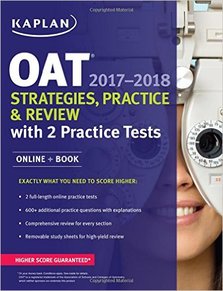oat information
The OAT is the Optometry Admissions Test and is an exam that must be taken in order to apply for optometry schools.
OAT Guide
Testing Checklist
FAQ
OAT Scoring
Online Registration to the OAT
UHCO Provided OAT Study Tools
UHCO Provided Sample OAT
Testing Checklist
FAQ
OAT Scoring
Online Registration to the OAT
UHCO Provided OAT Study Tools
UHCO Provided Sample OAT
FREQUENTLY ASKED QUESTIONS
What is the OAT?
The Optometry Admission Test (OAT) is a standardized examination designed to measure general academic ability and comprehension of scientific information. The OAT is sponsored by the Association of Schools and Colleges of Optometry (ASCO) for applicants seeking admission to an optometry program. All schools and colleges of optometry in the United States, and the University of Waterloo, Canada require the OAT.
What subjects does the OAT cover?
The OAT consists of four tests: Survey of the Natural Sciences (Biology, General Chemistry, and Organic Chemistry), Reading Comprehension, Physics and Quantitative Reasoning.
When should I take the OAT?
At least one year of college education, which should include courses in biology, general chemistry, organic chemistry and physics, is required prior to taking the OAT. Most students, however, elect to complete two or more years of college prior to taking the exam.
When is the OAT examination administered?
The OAT exam is computerized and examinees are allowed to take the OAT an unlimited number of times but must wait at least 90 days between testing dates. However, only scores from the four most recent attempts and the total number of attempts will be reported.
Where can I get more information about the OAT?
You can submit your application for the OAT examination and/or request additional copies of score reports online. You can view the Optometry Admission Testing Program - Online Candidate Guide, by clicking here: On-line Registration for OAT. For additional information on the OAT, please call or email the Optometric Admission Testing Program, 800-232-1694 ; [email protected].
- From the Association of Schools and Colleges of Optometry
The Optometry Admission Test (OAT) is a standardized examination designed to measure general academic ability and comprehension of scientific information. The OAT is sponsored by the Association of Schools and Colleges of Optometry (ASCO) for applicants seeking admission to an optometry program. All schools and colleges of optometry in the United States, and the University of Waterloo, Canada require the OAT.
What subjects does the OAT cover?
The OAT consists of four tests: Survey of the Natural Sciences (Biology, General Chemistry, and Organic Chemistry), Reading Comprehension, Physics and Quantitative Reasoning.
When should I take the OAT?
At least one year of college education, which should include courses in biology, general chemistry, organic chemistry and physics, is required prior to taking the OAT. Most students, however, elect to complete two or more years of college prior to taking the exam.
When is the OAT examination administered?
The OAT exam is computerized and examinees are allowed to take the OAT an unlimited number of times but must wait at least 90 days between testing dates. However, only scores from the four most recent attempts and the total number of attempts will be reported.
Where can I get more information about the OAT?
You can submit your application for the OAT examination and/or request additional copies of score reports online. You can view the Optometry Admission Testing Program - Online Candidate Guide, by clicking here: On-line Registration for OAT. For additional information on the OAT, please call or email the Optometric Admission Testing Program, 800-232-1694 ; [email protected].
- From the Association of Schools and Colleges of Optometry
OAT STUDY TOOLS
OAT Achiever: This resource comes with 3 full-fledged practice exams that you take on your computer. It is set up to be almost identical to the actual layout of the OAT. The exams are quite difficult and provide detailed responses. This program helps you nail the timing of the exam. Keep in mind that, come test time, you only realistically have 1 minute to work each problem, so it's very important to keep up your pace and not fall behind.
|
Kaplan OAT: The Kaplan OAT review book provides a thorough review of each of the subjects tested on the OAT and provides 2 practice tests to test your understanding of the material.
The Kaplan OAT prep course offers the entire question library (3,000+ items) available in the computer-based interface with 24/7 access. It also offers 5 full-length practice tests and a diagnostic exam for endurance and test strategy practice. The Kaplan class schedule offers 14 sessions designed to build content mastery and test taking skills sequentially. Kaplan has comprehensive review notes with more than 1,000 pages covering all OAT subjects. More information regarding Kaplan's services on our Helpful Links page |
Chad’s Videos a.k.a. Course Saver: These videos can be found at www.coursesaver.com. Chad is a dental student who decided to provide his own online lectures that prep from MCAT to DAT to OAT. It's only $80 for 2 months of access to all of his materials. He also has plenty of printable notes, quizzes, etc., accessible on his site.
http://chadsvideos.com/
http://chadsvideos.com/
Khan Academy: A website with free mini video lectures covering a variety of science topics.
https://www.khanacademy.org/
https://www.khanacademy.org/
ExamKrackers MCAT Audio Osmosis Audiobooks: Even though this tool is designed for MCAT preparation, it’s also a good OAT study aid. The lecturers’ sound effects & intonations clarify concepts in ways that can’t be duplicated in books. Tracking allows for easy repetition of important points. Crack the OAT: www.crackoat.com – This tool emulates the same platform interface & actual testing conditions of the OAT. Questions are thoroughly explained via hours of video explanations and written detailed explanations. This site provides the largest arsenal of practice tests for all of the OAT sections (except for physics).


